斯坦福卫生经济学教材(Health Economics)杰伊·巴塔查里亚《健康经济学》课程教学资源(PPT课件,英文版)Chapter 21 ECONOMIC EPIDEMIOLOGY
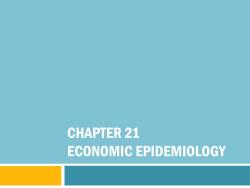
CHAPTER 21 ECONOMIC EPIDEMIOLOGY
CHAPTER 21 ECONOMIC EPIDEMIOLOGY
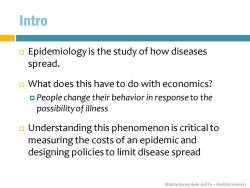
Intro Epidemiology is the study of how diseases spread. What does this have to do with economics? People change their behavior in response to the possibility of illness Understanding this phenomenon is critical to measuring the costs of an epidemic and designing policies to limit disease spread Bhattacharya,Hyde and Tu-HealthEconomics
Bhattacharya, Hyde and Tu – Health Economics Intro Epidemiology is the study of how diseases spread. What does this have to do with economics? People change their behavior in response to the possibility of illness Understanding this phenomenon is critical to measuring the costs of an epidemic and designing policies to limit disease spread
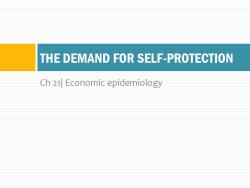
THE DEMAND FOR SELF-PROTECTION Ch 21 Economic epidemiology
Ch 21| Economic epidemiology THE DEMAND FOR SELF-PROTECTION
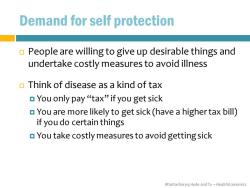
Demand for self protection People are willing to give up desirable things and undertake costly measures to avoid illness Think of disease as a kind of tax You only pay "tax"if you get sick You are more likely to get sick(have a higher tax bill) if you do certain things You take costly measures to avoid getting sick Bhattacharya,Hyde and Tu-HealthEconomics
Bhattacharya, Hyde and Tu – Health Economics Demand for self protection People are willing to give up desirable things and undertake costly measures to avoid illness Think of disease as a kind of tax You only pay “tax” if you get sick You are more likely to get sick (have a higher tax bill) if you do certain things You take costly measures to avoid getting sick
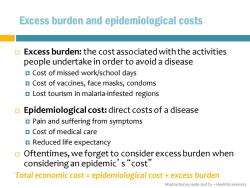
Excess burden and epidemiological costs Excess burden:the cost associated with the activities people undertake in order to avoid a disease Cost of missed work/school days Cost of vaccines,face masks,condoms Lost tourism in malaria-infested regions Epidemiological cost:direct costs of a disease Pain and suffering from symptoms ▣Cost of medical care Reduced life expectancy Oftentimes,we forget to consider excess burden when considering an epidemic's "cost' Total economic cost epidemiological cost excess burden Bhattacharya,Hyde and Tu-HealthEconomics
Bhattacharya, Hyde and Tu – Health Economics Excess burden and epidemiological costs Excess burden: the cost associated with the activities people undertake in order to avoid a disease Cost of missed work/school days Cost of vaccines, face masks, condoms Lost tourism in malaria-infested regions Epidemiological cost: direct costs of a disease Pain and suffering from symptoms Cost of medical care Reduced life expectancy Oftentimes, we forget to consider excess burden when considering an epidemic’ s “cost” Total economic cost = epidemiological cost + excess burden
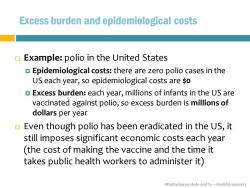
Excess burden and epidemiological costs o E Example:polio in the United States Epidemiological costs:there are zero polio cases in the US each year,so epidemiological costs are so Excess burden:each year,millions of infants in the US are vaccinated against polio,so excess burden is millions of dollars per year Even though polio has been eradicated in the US,it still imposes significant economic costs each year (the cost of making the vaccine and the time it takes public health workers to administer it) Bhattacharya,Hyde and Tu-HealthEconomics
Bhattacharya, Hyde and Tu – Health Economics Excess burden and epidemiological costs Example: polio in the United States Epidemiological costs: there are zero polio cases in the US each year, so epidemiological costs are $0 Excess burden: each year, millions of infants in the US are vaccinated against polio, so excess burden is millions of dollars per year Even though polio has been eradicated in the US, it still imposes significant economic costs each year (the cost of making the vaccine and the time it takes public health workers to administer it)
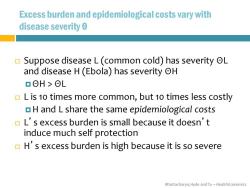
Excess burden and epidemiological costs vary with disease severity 0 日 Suppose disease L(common cold)has severity OL and disease H(Ebola)has severity H aΘH>ΘL L is 10 times more common,but 10 times less costly H and L share the same epidemiological costs L's excess burden is small because it doesn't induce much self protection H's excess burden is high because it is so severe Bhattacharya,Hyde and Tu-HealthEconomics
Bhattacharya, Hyde and Tu – Health Economics Excess burden and epidemiological costs vary with disease severity Θ Suppose disease L (common cold) has severity ΘL and disease H (Ebola) has severity ΘH ΘH > ΘL L is 10 times more common, but 10 times less costly H and L share the same epidemiological costs L’s excess burden is small because it doesn’t induce much self protection H’s excess burden is high because it is so severe
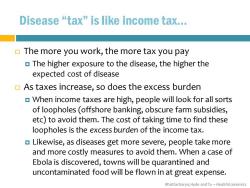
Disease“tax”is like income tax. The more you work,the more tax you pay The higher exposure to the disease,the higher the expected cost of disease As taxes increase,so does the excess burden When income taxes are high,people will look for all sorts of loopholes(offshore banking,obscure farm subsidies, etc)to avoid them.The cost of taking time to find these loopholes is the excess burden of the income tax. Likewise,as diseases get more severe,people take more and more costly measures to avoid them.When a case of Ebola is discovered,towns will be quarantined and uncontaminated food will be flown in at great expense. Bhattacharya,Hyde and Tu-HealthEconomics
Bhattacharya, Hyde and Tu – Health Economics Disease “tax” is like income tax… The more you work, the more tax you pay The higher exposure to the disease, the higher the expected cost of disease As taxes increase, so does the excess burden When income taxes are high, people will look for all sorts of loopholes (offshore banking, obscure farm subsidies, etc) to avoid them. The cost of taking time to find these loopholes is the excess burden of the income tax. Likewise, as diseases get more severe, people take more and more costly measures to avoid them. When a case of Ebola is discovered, towns will be quarantined and uncontaminated food will be flown in at great expense
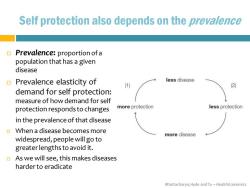
Self protection also depends on the prevalence Prevalence:proportion of a population that has a given disease Prevalence elasticity of less disease () (2) demand for self protection: measure of how demand for self protection responds to changes more protection less protection in the prevalence of that disease When a disease becomes more more disease widespread,people will go to greater lengths to avoid it. As we will see,this makes diseases harder to eradicate Bhattacharya,Hyde and Tu-HealthEconomics
Bhattacharya, Hyde and Tu – Health Economics Self protection also depends on the prevalence Prevalence: proportion of a population that has a given disease Prevalence elasticity of demand for self protection: measure of how demand for self protection responds to changes in the prevalence of that disease When a disease becomes more widespread, people will go to greater lengths to avoid it. As we will see, this makes diseases harder to eradicate
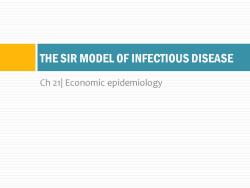
THE SIR MODEL OF INFECTIOUS DISEASE Ch 21 Economic epidemiology
Ch 21| Economic epidemiology THE SIR MODEL OF INFECTIOUS DISEASE
按次数下载不扣除下载券;
注册用户24小时内重复下载只扣除一次;
顺序:VIP每日次数-->可用次数-->下载券;
- 斯坦福卫生经济学教材(Health Economics)杰伊·巴塔查里亚《健康经济学》课程教学资源(PPT课件,英文版)Chapter 20 THE ECONOMICS OF HEALTH EXTERNALITIES.ppt
- 斯坦福卫生经济学教材(Health Economics)杰伊·巴塔查里亚《健康经济学》课程教学资源(PPT课件,英文版)Chapter 02 DEMAND FOR HEALTH CARE.ppt
- 斯坦福卫生经济学教材(Health Economics)杰伊·巴塔查里亚《健康经济学》课程教学资源(PPT课件,英文版)Chapter 19 POPULATION AGING AND THE FUTURE OF HEALTH POLICY.ppt
- 斯坦福卫生经济学教材(Health Economics)杰伊·巴塔查里亚《健康经济学》课程教学资源(PPT课件,英文版)Chapter 18 THE AMERICAN MODEL.ppt
- 斯坦福卫生经济学教材(Health Economics)杰伊·巴塔查里亚《健康经济学》课程教学资源(PPT课件,英文版)Chapter 17 THE BISMARCK MODEL - SOCIAL HEALTH INSURANCE.ppt
- 斯坦福卫生经济学教材(Health Economics)杰伊·巴塔查里亚《健康经济学》课程教学资源(PPT课件,英文版)Chapter 16 THE BEVERIDGE MODEL - NATIONALIZED HEALTH CARE.ppt
- 斯坦福卫生经济学教材(Health Economics)杰伊·巴塔查里亚《健康经济学》课程教学资源(PPT课件,英文版)Chapter 15 THE HEALTH POLICY CONUNDRUM.ppt
- 斯坦福卫生经济学教材(Health Economics)杰伊·巴塔查里亚《健康经济学》课程教学资源(PPT课件,英文版)Chapter 14 HEALTH TECHNOLOGY ASSESSMENT.ppt
- 斯坦福卫生经济学教材(Health Economics)杰伊·巴塔查里亚《健康经济学》课程教学资源(PPT课件,英文版)Chapter 13 TECHNOLOGY AND THE PRICE OF HEALTH CARE.ppt
- 斯坦福卫生经济学教材(Health Economics)杰伊·巴塔查里亚《健康经济学》课程教学资源(PPT课件,英文版)Chapter 12 PHARMACEUTICALS AND THE ECONOMICS OF INNOVATION.ppt
- 斯坦福卫生经济学教材(Health Economics)杰伊·巴塔查里亚《健康经济学》课程教学资源(PPT课件,英文版)Chapter 11 MORAL HAZARD.ppt
- 斯坦福卫生经济学教材(Health Economics)杰伊·巴塔查里亚《健康经济学》课程教学资源(PPT课件,英文版)Chapter 10 ADVERSE SELECTION IN REAL MARKETS.ppt
- 斯坦福卫生经济学教材(Health Economics)杰伊·巴塔查里亚《健康经济学》课程教学资源(PPT课件,英文版)Chapter 01 WHY HEALTH ECONOMICS?.ppt
- 斯坦福卫生经济学教材(Health Economics)杰伊·巴塔查里亚《健康经济学》课程教学资源(试卷习题,英文版)课后判断题及答案 Ch 9 Adverse Selection - The Rothschild-Stiglitz Model.pdf
- 斯坦福卫生经济学教材(Health Economics)杰伊·巴塔查里亚《健康经济学》课程教学资源(试卷习题,英文版)课后判断题及答案 Ch 8 Adverse Selection - Akerlof’s Market for Lemons.pdf
- 斯坦福卫生经济学教材(Health Economics)杰伊·巴塔查里亚《健康经济学》课程教学资源(试卷习题,英文版)课后判断题及答案 Ch 7 Demand for Insurance.pdf
- 斯坦福卫生经济学教材(Health Economics)杰伊·巴塔查里亚《健康经济学》课程教学资源(试卷习题,英文版)课后判断题及答案 Ch 6 The Hospital Industry.pdf
- 斯坦福卫生经济学教材(Health Economics)杰伊·巴塔查里亚《健康经济学》课程教学资源(试卷习题,英文版)课后判断题及答案 Ch 5 The Labor Market for Physicians.pdf
- 斯坦福卫生经济学教材(Health Economics)杰伊·巴塔查里亚《健康经济学》课程教学资源(试卷习题,英文版)课后判断题及答案 Ch 4 Socioeconomic Disparities in Health.pdf
- 斯坦福卫生经济学教材(Health Economics)杰伊·巴塔查里亚《健康经济学》课程教学资源(试卷习题,英文版)课后判断题及答案 Ch 3 Demand for Health:The Grossman Model.pdf
- 斯坦福卫生经济学教材(Health Economics)杰伊·巴塔查里亚《健康经济学》课程教学资源(PPT课件,英文版)Chapter 22 OBESITY.ppt
- 斯坦福卫生经济学教材(Health Economics)杰伊·巴塔查里亚《健康经济学》课程教学资源(PPT课件,英文版)Chapter 23 PROSPECT THEORY.ppt
- 斯坦福卫生经济学教材(Health Economics)杰伊·巴塔查里亚《健康经济学》课程教学资源(PPT课件,英文版)Chapter 24 TIME INCONSISTENCY AND HEALTH.ppt
- 斯坦福卫生经济学教材(Health Economics)杰伊·巴塔查里亚《健康经济学》课程教学资源(PPT课件,英文版)Chapter 03 CHAPTER 3 DEMAND FOR HEALTH:THE GROSSMAN MODEL.ppt
- 斯坦福卫生经济学教材(Health Economics)杰伊·巴塔查里亚《健康经济学》课程教学资源(PPT课件,英文版)Chapter 04 SOCIOECONOMIC DISPARITIES IN HEALTH.ppt
- 斯坦福卫生经济学教材(Health Economics)杰伊·巴塔查里亚《健康经济学》课程教学资源(PPT课件,英文版)Chapter 05 THE PHYSICIAN LABOR MARKET.ppt
- 斯坦福卫生经济学教材(Health Economics)杰伊·巴塔查里亚《健康经济学》课程教学资源(PPT课件,英文版)Chapter 06 THE HOSPITAL INDUSTRY.ppt
- 斯坦福卫生经济学教材(Health Economics)杰伊·巴塔查里亚《健康经济学》课程教学资源(PPT课件,英文版)Chapter 07 DEMAND FOR INSURANCE.ppt
- 斯坦福卫生经济学教材(Health Economics)杰伊·巴塔查里亚《健康经济学》课程教学资源(PPT课件,英文版)Chapter 08 ADVERSE SELECTION - AKERLOF’S MARKET FOR LEMONS.ppt
- 斯坦福卫生经济学教材(Health Economics)杰伊·巴塔查里亚《健康经济学》课程教学资源(PPT课件,英文版)Chapter 09 ADVERSE SELECTION - THE ROTHSCHILD-STIGLITZ MODEL.ppt
- 兰州交通大学:《微观经济学》课程教学资源(教案大纲)教学大纲 Microeconomics(负责人:李新文).pdf
- 兰州交通大学:《微观经济学》课程教学资源(教案大纲)微观经济学授课教案(打印版).pdf
- 兰州交通大学:《微观经济学》课程教学资源(案例分析)微观经济学教学案例(打印版).pdf
- 《微观经济学》课程教学资源(书籍文献)西方经济学名著选读.pdf
- 兰州交通大学:《微观经济学》课程教学资源(试卷习题)微观经济学各章习题库及参考答案(打印版,共十一章).pdf
- 兰州交通大学:《微观经济学》课程教学资源(试卷习题)微观经济学试题(A卷)试卷(打印版).pdf
- 兰州交通大学:《微观经济学》课程教学资源(试卷习题)微观经济学试卷(A卷)答案(打印版).pdf
- 兰州交通大学:《微观经济学》课程教学资源(课件讲稿,打印版)第一章 导论(负责人:李新文).pdf
- 兰州交通大学:《微观经济学》课程教学资源(课件讲稿,打印版)第二章 需求曲线和供给曲线以及均衡价格(供给需求和均衡价格).pdf
- 兰州交通大学:《微观经济学》课程教学资源(课件讲稿,打印版)第三章 效用论.pdf
